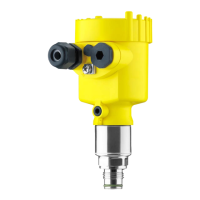17
4 Mounting
VEGABAR 83 • 4 … 20 mA/HART
45036-EN-171120
4 Mounting
4.1 General instructions
Make sure before mounting that all parts of the instrument exposed to
the process are suitable for the existing process conditions.
These are mainly:
•
Active measuring component
•
Processtting
•
Process seal
Process conditions in particular are:
•
Process pressure
•
Process temperature
•
Chemical properties of the medium
•
Abrasionandmechanicalinuences
Youcannddetailedinformationontheprocessconditionsinchapter
"Technical data" as well as on the type label.
The instrument is suitable for standard and extended ambient condi-
tions acc. to DIN/EN/IEC/ANSI/ISA/UL/CSA 61010-1.
Protect your instrument against moisture ingress through the following
measures:
•
Use a suitable connection cable (see chapter "Connecting to
power supply")
•
Tighten the cable gland
•
When mounting horizontally, turn the housing so that the cable
gland points downward
•
Loop the connection cable downward in front of the cable gland
This applies mainly to outdoor installations, in areas where high
humidity is expected (e.g. through cleaning processes) and on cooled
or heated vessels.
To maintain the housing protection, make sure that the housing lid is
closed during operation and locked, if necessary.
Makesurethatthedegreeofcontaminationspeciedinchapter
"Technical data" meets the existing ambient conditions.
Metric threads
In the case of instrument housings with metric thread, the cable
glands are screwed in at the factory. They are sealed with plastic
plugs as transport protection.
You have to remove these plugs before electrical connection.
NPT thread
In the case of instrument housings with self-sealing NPT threads, it is
not possible to have the cable entries screwed in at the factory. The
free openings for the cable glands are therefore covered with red dust
protection caps as transport protection. The dust protection caps do
notprovidesucientprotectionagainstmoisture.
Suitability for the process
conditions
Suitability for the ambient
conditions
Protection against mois-
ture
Cable glands

